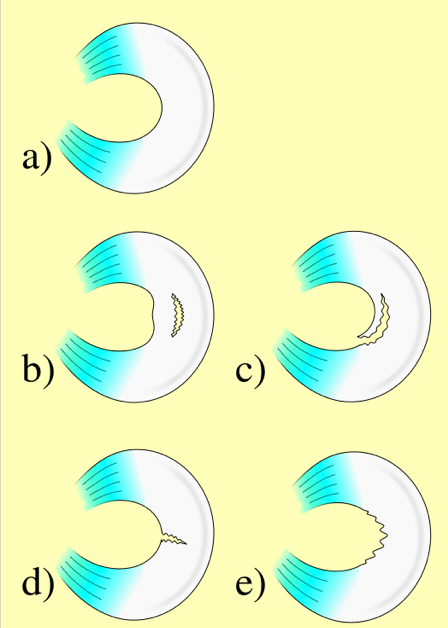Meniscus Injury Overview
The meniscus is a small "c" shaped cartilage structure within the knee. that acts as a cushion in the knee joint. There are 2 menisci in each knee. The menisci sit between the thigh bone (femur) and the tibia (shin bone) acting as shock absorbers —one of these is located on the outside of the knee (the lateral meniscus) and the other on the inside of the knee (the medial meniscus). The medial meniscus bears up to 50% of the load applied to the inside compartment of the knee, while the lateral meniscus absorbs up to 80% of the load on the outside compartment of the knee.
The meniscus plays an important role in the knee because it helps in load transmission across the knee joint, aids in joint stability, helps protect the ligaments against excessive force, and provides lubrication. The menisci are frequently injured in sports, and meniscus tears can occur with other knee injuries such as ACL tears. Years ago, it was common practice to completely remove a damaged meniscus following a knee injury. This frequently led to arthritis and other degenerative conditions including a "bow-legged" or "knock-kneed" deformity. Today, the meniscus is usually saved if possible and repaired if injured because orthopedic physicians agree that it plays a significant role in the overall health of the knee.
Meniscal tears are among the most common type of knee injury that Dr. Millett treats. There are some important variables to assess:
- Location: The front portion of the meniscus is referred to as the anterior horn, the back portion is the posterior horn, and the middle section is the body. A posterior horn tear is the most common meniscus injury. In addition, the meniscus is also broken down into the outer, middle, and inner thirds. Tears in the outer 1/3 area have the best chance of healing because blood supply in this area is the strongest and helps aid in the healing process.
- Tear Pattern: Meniscus tears also come in many shapes including horizontal, longitudinal and radial. A complex tear will involve more than one pattern.
- Complete vs. Incomplete Tear: In addition, a meniscus tear will be classified as complete or incomplete. A tear is complete if it goes all the way through the meniscus and a piece of tissue becomes separated from the rest of the meniscus. If the tear is still partly attached to the body of the meniscus, it is considered incomplete. Some complete tears that can flip up are called "bucket handle tears."
- Acute vs. Degenerative Meniscus Injuries: Meniscus injuries are classified as acute or degenerative. Acute meniscal injuries occur most often when a person's knee is bent and twisted forcefully while weight-bearing. Statistics show that about 61 of 100,000 people experience an acute tear of the meniscus. Degenerative tears of the meniscus are more common in older people. 60% of the population over the age of 65 probably has some sort of degenerative tear of the meniscus. These tears are most likely result from minor injuries involving regular or sporting activity. Due to the gradual degeneration that happens slowly over time, patients may not present with symptoms.
Symptoms of a Meniscus Injury
Depending on the extent of the meniscus injury, pain can range from mild to severe. Most patients will experience swelling and a throbbing or sharp, knee pain. The knee may also be stiff and feel instable. In addition, a clicking or popping sound will be heard. If the injury is small, symptoms will usually go away without treatment. Dr. Millett will perform a thorough physical exam. He will check for tenderness along the joint line, where the meniscus sits. He will also perform a physical exam maneuver called the McMurray test where he will bend and rotate your knee. Pain, snapping, or locking during this maneuver are suggestive of a meniscus tear. Imaging may also be used such as X-ray and/or MRI.
Treatment for Meniscal Injuries
Non-Surgical
Treatment for meniscal injuries vary depending upon the extent and location of the meniscus tear. If the tear is small and the pain and other symptoms are minor, strengthening exercises and a small regime of physical therapy may be all that's needed to recover.
It is important to use rest, ice (cold packs for 20 minutes at a time), compression bandages, and elevation of the leg to reduce swelling. Medications such as aspirin or ibuprofen can help reduce pain and swelling as well.
For a larger tear, knee surgery will most likely be required and recommended.
Surgical
Large meniscus tears usually occur after more traumatic injury and generally requires meniscus tear repair surgery to treat the associated pain and mechanical problems. Dr. Millett will perform meniscus repair arthroscopically.
In arthroscopic surgical repair for a meniscus tear, two tiny incisions will be made and a small camera inserted so the joint can be reviewed and the torn pieces of meniscus can be repaired and/or removed. The goal is to save as much of the original, normal meniscus cartilage as possible. During meniscus repair surgery, if the torn section of meniscus is removed, then it is known as a partial meniscectomy. If the meniscus can be repaired, then the torn edges are joined back together with sutures.
Rehabilitation after meniscus surgery involves physical therapy and rest for a period of months. Specific rehabilitation will vary according to each patient's needs. Strictly adhering to the protocol that Dr. Millett and your physical therapist design for you is essential and will optimize your results.

